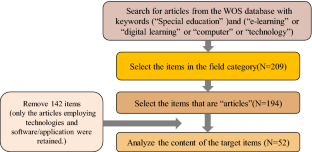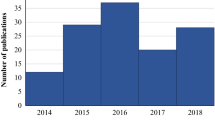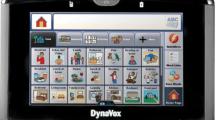Abstract
Owing to physical or mental disabilities, disabled students often come across more difficulties in learning. In an effort to improve their learning, researchers have adopted technology-supported tools to enhance disabled students’ adaptability to the learning environment and their learning achievement. The application of technology-supported special education has gradually increased in recent years. However, there is still a lack of investigation and analysis of the application and development trends of integrating technologies into special education. The aim of the present study was therefore to review technology-supported special education research articles by taking multiple dimensions into account, such as learning devices, learning strategies, learning domains and research issues, research subjects, types and level of disabilities, and learning environments. Based on the results, the number of studies has increased year by year, and the choice of learning devices and applications has become increasingly diverse; yet, the learning strategies still tend to be conservative since the majority of studies adopted the guided learning strategy. In addition, the application of technology has expanded to every learning domain, but is mainly focused on elementary school students and resource classrooms. Most importantly, the implementation of technology-supported special education tends not to result in teaching difficulties due to disabled students having different types and levels of disabilities. Further discussion and suggestions based on the findings can serve as a reference for teachers and researchers in special education.











Similar content being viewed by others
References
Abidoğlu, Ü. P., Ertuğruloğlu, O., & Büyükeğilmez, N. (2017). Importance of computer-aided education for children with autism spectrum disorder (ASD). Eurasia Journal of Mathematics, Science and Technology Education,13(8), 4957–4964.
Akçayır, M., & Akçayır, G. (2017). Advantages and challenges associated with augmented reality for education: A systematic review of the literature. Educational Research Review,20, 1–11.
Albarran, S. A., & Sandbank, M. P. (2019). Teaching non-target information to children with disabilities: An examination of instructive feedback literature. Journal of Behavioral Education,28(1), 107–140. https://doi.org/10.1007/s10864-018-9301-3.
Alzrayer, N. M., & Banda, D. R. (2017). Implementing tablet-based devices to improve communication skills of students with autism. Intervention in School and Clinic,53(1), 50–57.
Avcioglu, H. (2013). Effectiveness of video modelling in training students with intellectual disabilities to greet people when they meet. Educational Sciences: Theory and Practice,13(1), 466–477.
Bakker, M., van den Heuvel-Panhuizen, M., & Robitzsch, A. (2016). Effects of mathematics computer games on special education students’ multiplicative reasoning ability. British Journal of Educational Technology,47(4), 633–648.
Barton, E. E., Pustejovsky, J. E., Maggin, D. M., & Reichow, B. (2017). Technology-aided instruction and intervention for students with ASD: A meta-analysis using novel methods of estimating effect sizes for single-case research. Remedial and Special Education,38(6), 371–386.
Beal-Alvarez, J. S., & Huston, S. G. (2014). Emerging evidence for instructional practice: Repeated viewings of sign language models. Communication Disorders Quarterly,35(2), 93–102.
Blumberg, S. J., Bramlett, M. D., Kogan, M. D., Schieve, L. A., Jones, J. R., & Lu, M. C. (2013). Changes in prevalence of parent-reported autism spectrum disorder in school-aged US children: 2007 to 2011–2012 (No. 65). US Department of Health and Human Services, Centers for Disease Control and Prevention, National Center for Health Statistics.
Campigotto, R., McEwen, R., & Epp, C. D. (2013). Especially social: Exploring the use of an iOS application in special needs classrooms. Computers & Education,60(1), 74–86.
Chang, C. Y., & Hwang, G. J. (2018). Trends of mobile technology-enhanced medical education: A review of journal publications from 1998 to 2016. International Journal of Mobile Learning and Organisation,12(4), 373–393.
Chang, C. Y., Lai, C. L., & Hwang, G. J. (2018). Trends and research issues of mobile learning studies in nursing education: A review of academic publications from 1971 to 2016. Computers & Education,116, 28–48.
Chen, C. H., Chou, Y. Y., & Huang, C. Y. (2016). An augmented-reality-based concept map to support mobile learning for science. The Asia-Pacific Education Researcher,25(4), 567–578.
Chiang, H. Y. A., & Jacobs, K. (2010). Perceptions of a computer-based instruction system in special education: High school teachers and students views. Work,37(4), 349–359.
Cinquin, P. A., Guitton, P., & Sauzéon, H. (2019). Online e-learning and cognitive disabilities: A systematic review. Computers & Education,130, 152–167. https://doi.org/10.1016/j.compedu.2018.12.004.
Conti-Ramsden, G., Durkin, K., & Walker, A. J. (2010). Computer anxiety: A comparison of adolescents with and without a history of specific language impairment (SLI). Computers & Education,54(1), 136–145.
Cumming, T. M., & Draper Rodríguez, C. (2017). A meta-analysis of mobile technology supporting individuals with disabilities. The Journal of Special Education,51(3), 164–176.
Cumming, T. M., Strnadova, I., & Singh, S. (2014). iPads as instructional tools to enhance learning opportunities for students with developmental disabilities: An action research project. Action Research,12(2), 151–176.
Drigas, A., Ioannidou, R. E., Kokkalia, G., & Lytras, M. D. (2014). ICTs, mobile learning and social media to enhance learning for attention difficulties. J. UCS,20(10), 1499–1510.
Evmenova, A. S., Regan, K., Boykin, A., Good, K., Hughes, M., MacVittie, N.,… & Chirinos, D. (2016). Emphasizing planning for essay writing with a computer-based graphic organizer. Exceptional Children, 82(2), 170–191
FernáNdez-LóPez, Á., RodríGuez-FóRtiz, M. J., RodríGuez-Almendros, M. L., & MartíNez-Segura, M. J. (2013). Mobile learning technology based on iOS devices to support students with special education needs. Computers & Education,61, 77–90.
Fitzgerald, G., Koury, K., & Mitchem, K. (2008). Research on computer-mediated instruction for students with high incidence disabilities. Journal of Educational Computing Research,38(2), 201–233.
Florian, L. (2008). Inclusion: Special or inclusive education: Future trends. British Journal of Special Education,35(4), 202–208.
Fu, Q. K., & Hwang, G. J. (2018). Trends in mobile technology-supported collaborative learning: A systematic review of journal publications from 2007 to 2016. Computers & Education,119, 129–143.
Fu, Q. K., Lin, C. J., & Hwang, G. J. (2019). Research trends and applications of technology-supported peer assessment: A review of selected journal publications from 2007 to 2016. Journal of Computers in Education,6(2), 191–213. https://doi.org/10.1007/s40692-019-00131-x.
Hess, K. L., Morrier, M. J., Heflin, L. J., & Ivey, M. L. (2008). Autism treatment survey: Services received by children with autism spectrum disorders in public school classrooms. Journal of Autism and Developmental Disorders,38(5), 961–971.
Hooshyar, D., Yousefi, M., & Lim, H. (2019). A systematic review of data-driven approaches in player modeling of educational games. Artificial Intelligence Review,52(3), 1997–2017. https://doi.org/10.1007/s10462-017-9609-8.
Hu, X. Y., & Han, Z. R. (2019). Effects of gesture-based match-to-sample instruction via virtual reality technology for Chinese students with autism spectrum disorders. International Journal of Developmental Disabilities,65(5), 327–336. https://doi.org/10.1080/20473869.2019.1602350.
Hwang, G. J., Chu, H. C., & Lai, C. L. (2017). Prepare your own device and determination (PYOD): A successfully promoted mobile learning mode in Taiwan. International Journal of Mobile Learning and Organisation,11(2), 87–107.
Hwang, G. J., Tsai, C. C., & Yang, S. J. H. (2008). Criteria, strategies and research issues of context-aware ubiquitous learning. Educational Technology & Society,11(2), 81–91.
Hwang, G. J., & Wu, P. H. (2014). Applications, impacts and trends of mobile learning—A review of 2008–2012 publications in selected journals. International Journal of Mobile Learning and Organisation,8(2), 83–95.
Karanfiller, T., Göksu, H., & Yurtkan, K. (2017). A mobile application design for students who need special education. Egitim ve Bilim. https://doi.org/10.15390/EB.2017.7146.
Ke, F., Im, T., Xue, X., Xu, X., Kim, N., & Lee, S. (2015). Experience of adult facilitators in a virtual-reality-based social interaction program for children with autism. The Journal of Special Education,48(4), 290–300.
Kiboss, J. K. (2012). Effects of special e-learning program on hearing-impaired learners’ achievement and perceptions of basic geometry in lower primary mathematics. Journal of Educational Computing Research,46(1), 31–59.
Koedinger, K. R., McLaughlin, E. A., & Heffernan, N. T. (2010). A quasi-experimental evaluation of an on-line formative assessment and tutoring system. Journal of Educational Computing Research,43(4), 489–510.
Kwon, J., & Lee, Y. (2016). Serious games for the job training of persons with developmental disabilities. Computers & Education,95, 328–339.
Lamsa, J., Hamalainen, R., Aro, M., Koskimaa, R., & Ayramo, S. M. (2018). Games for enhancing basic reading and maths skills: A systematic review of educational game design in supporting learning by people with learning disabilities. British Journal of Educational Technology,49(4), 596–607.
Ledford, J. R., Lane, J. D., Elam, K. L., & Wolery, M. (2012). Using response-prompting procedures during small-group direct instruction: Outcomes and procedural variations. American Journal on Intellectual and Developmental Disabilities,117(5), 413–434.
Lin, H. C., & Hwang, G. J. (2018). Research trends of flipped classroom studies for medical courses: A review of journal publications from 2008 to 2017 based on the technology-enhanced learning model. Interactive Learning Environments,27(8), 1011–1027. https://doi.org/10.1080/10494820.2018.1467462.
Lin, T. C., Lin, T. J., & Tsai, C. C. (2014). Research trends in science education from 2008 to 2012: A systematic content analysis of publications in selected journals. International Journal of Science Education,36(8), 1346–1372.
Liu, G. Z., Wu, N. W., & Chen, Y. W. (2013). Identifying emerging trends for implementing learning technology in special education: A state-of-the-art review of selected articles published in 2008–2012. Research in Developmental Disabilities,34(10), 3618–3628.
Marino, M. T., & Beecher, C. C. (2010). Conceptualizing RTI in 21st-century secondary science classrooms: Video games’ potential to provide tiered support and progress monitoring for students with learning disabilities. Learning Disability Quarterly,33(4), 299–311.
Martella, R. C., & Marchand-Martella, N. E. (2015). Improving classroom behavior through effective instruction: An illustrative program example using SRA FLEX literacy. Education and Treatment of Children,38(2), 241–271.
Nepo, K. (2017). The use of technology to improve education. Child & Youth Care Forum,46(2), 207–221.
Odom, S. L., Thompson, J. L., Hedges, S., Boyd, B. A., Dykstra, J. R., Duda, M. A., et al. (2015). Technology-aided interventions and instruction for adolescents with autism spectrum disorder. Journal of Autism and Developmental Disorders,45(12), 3805–3819.
Ok, M. W., & Kim, W. (2017). Use of iPads and iPods for academic performance and engagement of prek-12 students with disabilities: A research synthesis. Exceptionality,25(1), 54–75.
Ok, M. W., Kim, M. K., Kang, E. Y., & Bryant, B. R. (2016). How to find good apps: An evaluation rubric for instructional apps for teaching students with learning disabilities. Intervention in School and Clinic,51(4), 244–252.
Okolo, C. M., Englert, C. S., Bouck, E. C., Heutsche, A., & Wang, H. (2011). The virtual history museum: Learning US history in diverse eighth grade classrooms. Remedial and Special Education,32(5), 417–428.
Özdemir, D., & Karaman, S. (2017). Investigating interactions between students with mild mental retardation and humanoid robot in terms of feedback types. Egitim ve Bilim. https://doi.org/10.15390/EB.2017.6948.
Polat, E., Adiguzel, T., & Akgun, O. E. (2012). Adaptive web-assisted learning system for students with specific learning disabilities: A needs analysis study. Kuram Ve Uygulamada Egitim Bilimleri,12(4), 3243–3258.
Rahimi, E., van den Berg, J., & Veen, W. (2015). Facilitating student-driven constructing of learning environments using Web 2.0 personal learning environments. Computers & Education,81, 235–246.
Rakap, S. (2010). Impacts of learning styles and computer skills on adult students’ learning online. TOJET: The Turkish Online Journal of Educational Technology,9(2), 108–115.
Regan, K., Evmenova, A. S., Boykin, A., Sacco, D., Good, K., Ahn, S. Y., et al. (2017). Supporting struggling writers with class-wide teacher implementation of a computer-based graphic organizer. Reading & Writing Quarterly,33(5), 428–448.
Rodríguez, C. D., & Cumming, T. M. (2017). Employing mobile technology to improve language skills of young students with language-based disabilities. Assistive Technology,29(3), 161–169.
Russak, S. (2016). Do inclusion practices for pupils with special educational needs in the English as a foreign language class in Israel reflect inclusion laws and language policy requirements? International Journal of Inclusive Education,20(11), 1188–1203.
Sara, S., & Heartley, H. (2019). Computer assisted instruction to teach academic content to students with intellectual disability: A review of the literature. American Journal on Intellectual and Developmental Disabilities,124(4), 374–390. https://doi.org/10.1352/1944-7558-124.4.374.
Shih, C. H., Wang, S. H., & Wang, Y. T. (2014). Assisting children with attention deficit hyperactivity disorder to reduce the hyperactive behavior of arbitrary standing in class with a Nintendo Wii remote controller through an active reminder and preferred reward stimulation. Research in Developmental Disabilities,35(9), 2069–2076.
Soykan, E., & Özdamlı, F. (2017). Evaluation of the android software for special needs children. Eurasia Journal of Mathematics, Science & Technology Education,13(6), 2683–2699.
Starcic, A. I., & Bagon, S. (2014). ICT-supported learning for inclusion of people with special needs: Review of seven educational technology journals, 1970–2011. British Journal of Educational Technology,45(2), 202–230.
Stephenson, J., & Limbrick, L. (2015). A review of the use of touch-screen mobile devices by people with developmental disabilities. Journal of Autism and Developmental Disorders,45(12), 3777–3791.
Thomas, C. N., Peeples, K. N., Kennedy, M. J., & Decker, M. (2019). Riding the special education technology wave: Policy, obstacles, recommendations, actionable ideas, and resources. Intervention in School and Clinic,54(5), 295–303. https://doi.org/10.1177/1053451218819201.
Tsiopela, D., & Jimoyiannis, A. (2017). Pre-vocational skills laboratory: Designing interventions to improve employment skills for students with autism spectrum disorders. Universal Access in the Information Society,16(3), 609–627.
Tu, Y. F., & Hwang, G. J. (2018). The roles of sensing technologies and learning strategies in library-associated mobile learning: A review of 2007–2016 journal publications. International Journal of Mobile Learning and Organisation,12(1), 42–54.
Vernon-Dotson, L. J., Floyd, L. O., Dukes, C., & Darling, S. M. (2014). Course delivery: Keystones of effective special education teacher preparation. Teacher Education and Special Education,37(1), 34–50. https://doi.org/10.1177/0888406413507728.
Walker, Z., Vasquez, E., & Wienke, W. (2016). The impact of simulated interviews for individuals with intellectual disability. Journal of Educational Technology & Society,19(1), 76.
Webber, J., Scheuermann, B., McCall, C., & Coleman, M. (1993). Research on self-monitoring as a behavior management technique in special education classrooms: A descriptive review. Remedial and Special Education,14(2), 38–56.
Wei, X., Yu, J. W., Shattuck, P., & Blackorby, J. (2017). High school math and science preparation and postsecondary STEM participation for students with an autism spectrum disorder. Focus on Autism and Other Developmental Disabilities,32(2), 83–92.
White, D. H., & Robertson, L. (2015). Implementing assistive technologies: A study on co-learning in the Canadian elementary school context. Computers in Human Behavior,51, 1268–1275.
Woodfine, B. P., Nunes, M. B., & Wright, D. J. (2008). Text-based synchronous e-learning and dyslexia: Not necessarily the perfect match! Computers & Education,50(3), 703–717.
Xu, Y. (2010). Examining the effects of digital feedback on student engagement and achievement. Journal of Educational Computing Research,43(3), 275–291.
Zhang, Y. (2000). Technology and the writing skills of students with learning disabilities. Journal of Research on Computing in Education,32(4), 467–479.
Acknowledgements
This study was supported in part by the Ministry of Science and Technology of the Republic of China under contract numbers MOST 106-2511-S-152-012-MY3.
Author information
Authors and Affiliations
Corresponding author
Ethics declarations
Conflict of interest
Moreover, the authors would like to state that there is no potential conflict of interest in this study, and the analyzed data can be provided upon requests via sending e-mails to the corresponding author.
Ethical approval
The study has been examined and advised by an academic ethics review committee. As the data were collected from an online database rather than a group of subjects, there is no privacy or personal rights problem in this study.
Additional information
Publisher's Note
Springer Nature remains neutral with regard to jurisdictional claims in published maps and institutional affiliations.
Rights and permissions
About this article
Cite this article
Cheng, SC., Lai, CL. Facilitating learning for students with special needs: a review of technology-supported special education studies. J. Comput. Educ. 7, 131–153 (2020). https://doi.org/10.1007/s40692-019-00150-8
Received:
Revised:
Accepted:
Published:
Issue Date:
DOI: https://doi.org/10.1007/s40692-019-00150-8




